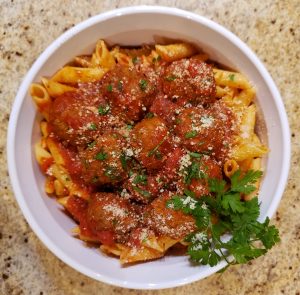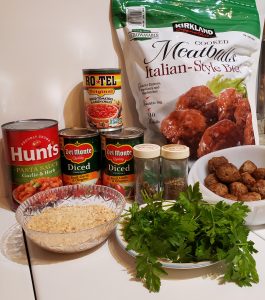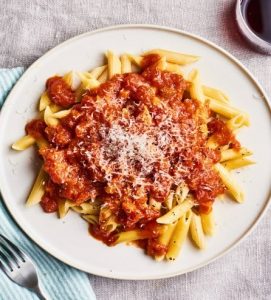A Little Sauce History
Whether it’s pasta with red, white or butter sauce, I think everyone will agree that Italian is a good old-fashioned comfort food! There are a couple names given to spaghetti sauce; Italians with roots straight from Italy call spaghetti sauce; ragù, sugo and salsa. American Italians from the East Coast call it “gravy” as discussed in Lorraine Ranalli’s book, Gravy Wars: South Philly Foods, Feuds & Attytudes. One thing is for sure, that Italians don’t have word or use “gravy” in Italian. Italians only say salsa, or ragù or sugo, which mean “sauce,” regardless if it contains meat or not.
The differences:
Ragù implies that the sauce was reduced, i.e. the flavors are concentrated, and the ingredients are usually cooked for a long time. The resulting sauce is used to dress pasta, fregola, polenta, rice. The Italian expression ‘ragú’ is derived from the French ‘ragout’-it is a thick stew of meat, poultry or fish with or without vegetables.
Sugo is often used interchangeably with ‘ragú’- different regions of Italy prefer one term above the other, but generally a ragú is cooked on low heat for a long time and the flavors are concentrated.

Photo by C.Gonzalez
Salsa or Pomodoro Salsa is an alternative to a long cooking sauce. This simple type of spaghetti sauce is made with very few ingredients; fresh tomatoes, olive oil, garlic, onion, and fresh herbs (such as basil, oregano, and parsley) with a pinch of salt and pepper. There is no meat or vegetables are added to this sauce. This is an easy, fragrant and perfect summer sauce poured over any pasta.
Fettuccini Alfredo sauce is a big Italian myth along with its most famous use in Fettuccini noodle. The name “Alfredo sauce” is almost completely absent in Italy. However, there are plenty of pasta sauces which are similarly based on the combination of butter and Parmigiano that are known as “al burro” with butter. In Rome, egg noodles with butter and Parmigiano are often called “alla Romana”, Roman style.
Did you know…
- A little history behind Fettuccini Alfredo is a bit of a mixed legend. In 1914, Alfredo di Lelio, a Roman restaurateur who was popular among American tourists, named his butter and cheese linguine after himself. According to the legend, the dish caught the attention of early Hollywood actors Mary Pickford and Douglas Fairbanks, who were in Rome for their honeymoon. When they returned to the US, the actors introduced the dish to their Hollywood friends, making it famous. In 1943 Alfredo di Lelio sold his restaurant, but the new owner kept the menu and is still in business under the name “Alfredo alla Scrofa“. In 1950, Alfredo di Lelio and his son opened a new restaurant in a different location and called it “Il vero Alfredo“, the real Alfredo, which is now managed by Alfredo’s nephews. Both restaurants are popular with North American tourists that want to taste the original Alfredo recipe. Besides these two restaurants, in Italy, “Alfredo” is just a first name (Alfred).
- Spaghetti with meatballs is an American invention. Yes, that right, only American Italians eat their spaghetti and meatballs. If you ever get the opportunity to visit Italy, NEVER ask for spaghetti and meat balls. Spaghetti and meatballs are practically non-existent in Italy, instead, meatballs are eaten together with a side dish of some type of vegetable or salad on their own. There are many variations of meatballs or as the Italian call them ‘polpette’, are found almost everywhere in the Italy. As the Italians assimilated into the American culture, they also began to switch to a large single course (as opposed to multiple smaller courses). This resulted in the combination of spaghetti and meatballs in a rich tomato sauce, which turned into the iconic dish we all know today; spaghetti and meatballs.
- When it comes to cuisine, Italians take things quite seriously. The main meal of the day occurs at lunch, also known as il pranzo, or ‘the lunch’. This mean starts with antipasti, commonly referred to as appetizers in America. Antipasti consists of hors d’oeuvres such as olives, cheese, and salami. The first course, il primo, follows with delights such as pasta, or minestrone; a type of soup. Afterwards, il secondo, and the main course, arrives. Meat, fish, and a vegetable-dominated salad are served during this period. To conclude the overall meal, fruit, dessert, and espresso are served.
My story
I grew up on the Eastside of Los Angeles with my big Italian family. Most of our family lived within a block and a half radius from each other. As I grew into a young girl, I hung out in the kitchen with my mom, aunts, and grandmother; where life was shared, and recipes were passed down over the years. Understanding who we are and where we came from is important in how we pass down those special traditional dishes. My sisters’ brother, and I are first generation born here in the United States. My grandparents and my parents, and their siblings were all born back in Italy. At times it felt like a little Italy when were all got together, which was all the time.
The one dish I loved the most was my grandma Nani’s pasta with red sauce. This was our family favorite dish and still is. We all knew when she was cooking her sauce because we could smell it while we all played outside. The smell of simmering spaghetti sauce still takes me back to the great days of when we would all run it and fight for a seat about the table to eat her pasta with meatballs. Tutti a tavolo (everyone to the table)! Is something my grandma and mom call out when our meal was ready.
But, aside from my family, our neighborhood, especially on my block; there were families of various nationalities; Polish, Japanese, German, but majority were Mexican. I loved growing up and hanging out at each other’s houses. That’s how I was introduced to spicy Mexican food. I love the heat of the spicy peppers.
When I got married and had a family of my own, I learned how to make my mother’s spaghetti sauce. I wanted them to enjoy that rich flavorful taste that I grew up with and loved. As the years passed the recipe took on a new tradition; my new tradition. I tried to stay as close to their recipe as possible but growing up on the Eastside of Los Angeles my taste for spicy foods became a part of my life which extended into my cooking the kitchen. Not only did my taste change my life did as well. When my household went from a two-parent household to a one parent household, which meant I had to cut down on meal preparation time to cooked meals for my kids. As a single working mom, with two kids, homemade spaghetti sauce and meatballs from scratch was a very time-consuming process and I had to restructure and prioritize my time. I found that some canned tomato sauces had good flavor and began to use them in my sauce. One weekend was making my sauce and did not have enough canned diced tomatoes so I decided to substitute one can with RO*TEL green chilies. My kids also like spicy food so this was a bit of an experiment as I did not know how my kids would react to this little surprise. I served it to my kids, and they loved it. Now, I know it would have to pass the “mom” test. I invited my mom over to sample my “new and improved” sauce, and much to my surprise my mom loved it. As a matter of fact, my mom and sister use my recipe when they make their Sunday dinners or when we have our family get together, they always ask me to bring the pasta with my sauce. Maybe this easy recipe will inspire you to create your own new traditions.
Ingredients
1 – 24 oz. can Del Monte or Hunt’s Tomato & Basil Pasta Sauce

1 – 14 oz. can Del Monte Diced Tomatoes with Basil, Garlic & Oregano
1 – 10 oz. can RO*TEL Original Diced Tomatoes with Green Chilies
6-10 large leaves of fresh basil, torn, or 1 Tbsp. dried basil
1 tsp. dried oregano or Italian seasoning (optional)
Salt and pepper to taste (optional)
10 – 12 Meatballs (Costco or any type of cooked meat)
1 lb. pasta or spaghetti
Grated Parmesan or Pecorino Romano cheese
Directions
-

Photo by C.Gonzalez
In a medium/large saucepan pour in the canned pasta sauce, diced tomatoes, and the RO*TEL green chilies, Basil or you favorite Italian spices, and simmer on a medium heat.
At this point you can add in the meatballs or half cooked sausage (I usually partially cook them in the microwave to cut down on the cook time) into the simmering tomato sauce for 30 – 40 mins. Until the meats are completely cooked.
- Bring a large pot of lightly salted water to a boil. Cook pasta in the boiling water, stirring occasionally, until cooked through but firm to the bite, according to the direction on the package. Drain.
- Stir tomato mixture into pasta and season with salt and pepper. Toss warm pasta with Grated Parmesan or Pecorino Romano cheese to taste cheese in a large bowl.
The nutritional benefits of spaghetti sauce:

Photographer unknown
If you’re like me and don’t have a lot of time and the inclination of how to make your own pasta sauce there are some types of canned pasta sauce are relatively healthy. Check the fat, sugar, sodium and calorie contents on the nutrition facts label to find the healthiest variety of the type of sauce you are considering. Red sauces are low in saturated fat and all offer plenty of vitamins A and C and lycopene, an antioxidant. Adding extras such as cheese, meats, and cream add calories, salt and saturated fat. Look at the daily value percentages too. A daily value (DV) of 15 per cent or more for vitamins A and C mean that one serving is a good source of those nutrients.
One last tip: Although nutrition information typically provided for 1/2 cup of pasta sauce, most people pour at least one cup on their noodles. So you’ll need to double the numbers.
References:
Author, Speaker, Voice-over. (n.d.). Retrieved from http://lorraineranalli.com/
Bowen, D. (n.d.). Ragù Around Italy. Retrieved from https://www.saveur.com/article/Kitchen/Ragu-Around-Italy/
Duggan, T. (2012, January 20). SEDUCED BY SUGO / Long-cooked Italian sauces captivate chefs and diners. Retrieved from https://www.sfgate.com/recipes/article/SEDUCED-BY-SUGO-Long-cooked-Italian-sauces-2647395.php
Blair, Blair, Wallace, W., Finkle, J., Sullivan, R., Sheila, … Chelsea C. (2019, May 27). 5-Ingredient Pasta Pomodoro Sauce. Retrieved from https://www.theseasonedmom.com/5-ingredient-pasta-pomodoro-sauce/
Ristorante di Roma – Alfredo alla Scrofa. (n.d.). Retrieved from https://www.alfredoallascrofa.com/chi-siamo
Il Vero Alfredo “The Real Alfredo”. (n.d.). Retrieved from http://www.ilveroalfredo.it/index-eng.htm
The Advantages of Tomato Sauce. (n.d.). Retrieved from https://www.livestrong.com/article/522521-the-advantages-of-tomato-sauce/

Pingback: Cookbook Index | IDS 336: American Appetites